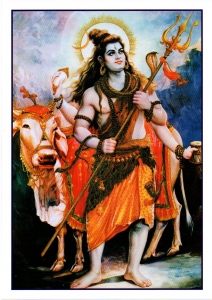Shiva
 Download PDF: PCT-303
Download PDF: PCT-303
- Shiva is one of the Trimurti. He presides over tama-guna (the quality of darkness) and is responsible for the destruction of the material world.
- He is also considered the supreme male principle (purusha), the husband of mother nature (Shakti) and is therefore also associated with creation. He is often worshipped through the linga, representing his identity as the male creative principle.
- Shiva is one of the three main focusses of worship
- Shiva is usually considered to be of whitish complexion with a blue throat. Most often, he appears in paintings and illustrations with a blue-black complexion.
- He is usually depicted as a yogi seated in meditation in the Himalayas. He wears a tiger skin and is smeared in ashes. He carries a trishul (trident) and a small drum (called a damaru). He is often shown with a third eye and with snakes coiled round his neck and arms. In his matted and coiled locks are the crescent moon and the Ganges as it descends from the heavenly realm.
- Shiva’s abode is Mount Kailash, of which an earthly replica is found in the Himalayas
- Shiva is considered timeless, but he appeared in this universe from the forehead of Brahma who became angry when his four celibate sons, the Kumaras, refused his request to get married. His eleven ‘Rudra’ forms are connected with anger, fierce animals and storms, and were apparently prevalent in earlier Hinduism.
- Shiva’s consort is Shakti also known as Parvati, Sati, Uma, Devi, etc. The couple are often worshipped together and a whole theology has developed around these complementary male-female principles (Shiva-Shakti).
- Many tantric traditions are related to the dual worship of Shiva-Shakti
- Shiva is often worshipped in his form as the linga, representing his identity as the male principle within the world.
- Another popular form is Nataraj (the king of dancers). Images of this form are more often for aesthetic use rather than used in worship. Shiva is reputed to dance wildly and beat his drum at the time of universal destruction.
- Shiva’s carrier is Nandi the bull, who often features in temples facing his lord.
- The main festival associated with Shiva is Maha Shiva Ratri (February/March), which celebrates his marriage to Parvati.
- Stories include;
- “Shiva drinks the poison” STO – 311
- “Shiva and Vrikasura” STO – 312
- “Daksha’s sacrifice”
- “Shiva destroys the three cities of the Demons”
- Further references:
- Teachers’ Book: pages 48-52, 67, 71-72, 74-75, 113, 132, 135, 137
- CD-Rom: PIC-048(c), TGD-04, STO-311 & 312
- Audio CD: track 16
- http://www.hindunet.org/god/trinity/shiva/
